2022 HYUNDAI GENESIS GV70 air condition
[x] Cancel search: air conditionPage 594 of 647
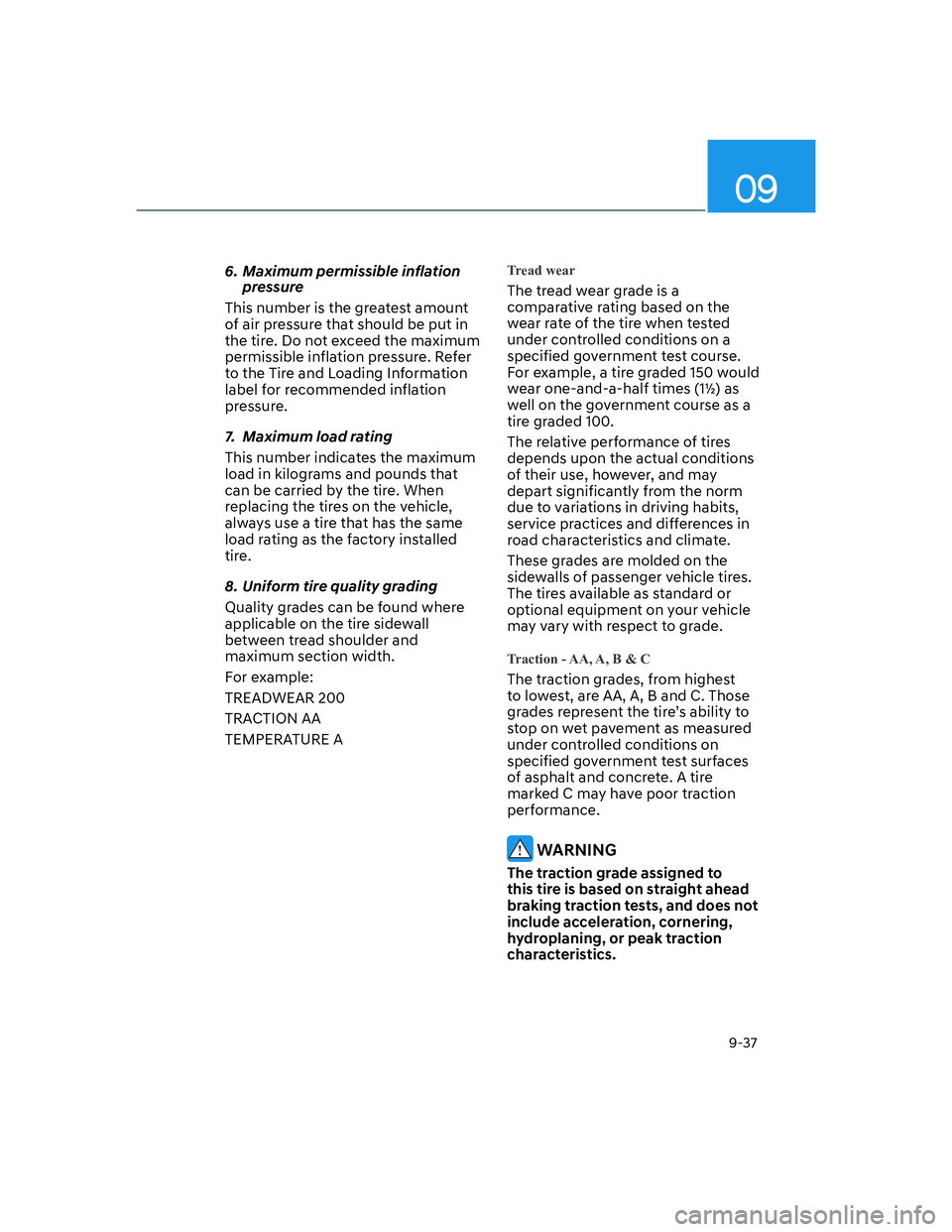
09
9-37
6. Maximum permissible inflation
pressure
This number is the greatest amount
of air pressure that should be put in
the tire. Do not exceed the maximum
permissible inflation pressure. Refer
to the Tire and Loading Information
label for recommended inflation
pressure.
7. Maximum load rating
This number indicates the maximum
load in kilograms and pounds that
can be carried by the tire. When
replacing the tires on the vehicle,
always use a tire that has the same
load rating as the factory installed
tire.
8. Uniform tire quality grading
Quality grades can be found where
applicable on the tire sidewall
between tread shoulder and
maximum section width.
For example:
TREADWEAR 200
TRACTION AA
TEMPERATURE ATr e a d w e a r
The tread wear grade is a
comparative rating based on the
wear rate of the tire when tested
under controlled conditions on a
specified government test course.
For example, a tire graded 150 would
wear one-and-a-half times (1½) as
well on the government course as a
tire graded 100.
The relative performance of tires
depends upon the actual conditions
of their use, however, and may
depart significantly from the norm
due to variations in driving habits,
service practices and differences in
road characteristics and climate.
These grades are molded on the
sidewalls of passenger vehicle tires.
The tires available as standard or
optional equipment on your vehicle
may vary with respect to grade.
Traction - AA, A, B & C
The traction grades, from highest
to lowest, are AA, A, B and C. Those
grades represent the tire’s ability to
stop on wet pavement as measured
under controlled conditions on
specified government test surfaces
of asphalt and concrete. A tire
marked C may have poor traction
performance.
WARNING
The traction grade assigned to
this tire is based on straight ahead
braking traction tests, and does not
include acceleration, cornering,
hydroplaning, or peak traction
characteristics.
Page 595 of 647
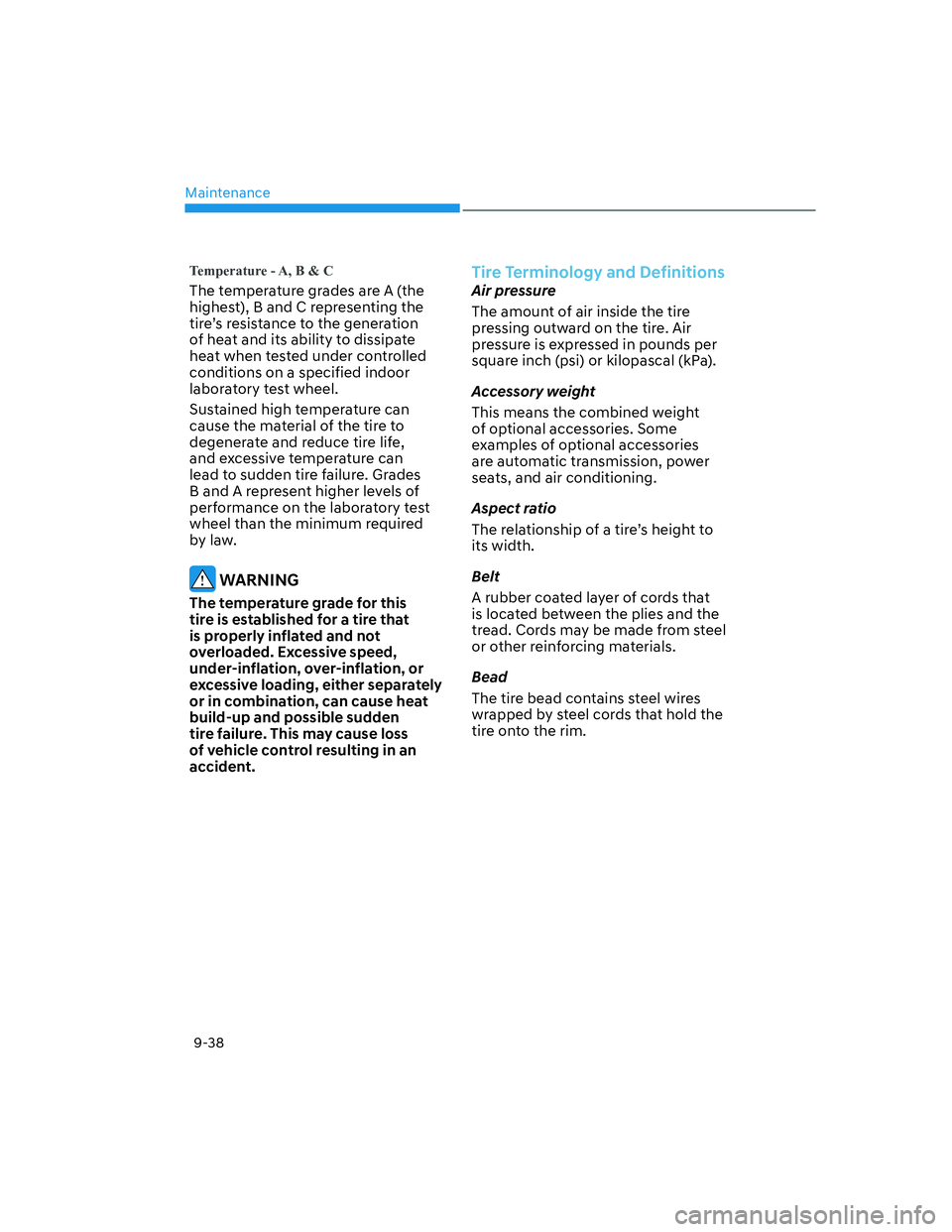
Maintenance
9-38
Temperature - A, B & C
The temperature grades are A (the
highest), B and C representing the
tire’s resistance to the generation
of heat and its ability to dissipate
heat when tested under controlled
conditions on a specified indoor
laboratory test wheel.
Sustained high temperature can
cause the material of the tire to
degenerate and reduce tire life,
and excessive temperature can
lead to sudden tire failure. Grades
B and A represent higher levels of
performance on the laboratory test
wheel than the minimum required
by law.
WARNING
The temperature grade for this
tire is established for a tire that
is properly inflated and not
overloaded. Excessive speed,
under-inflation, over-inflation, or
excessive loading, either separately
or in combination, can cause heat
build-up and possible sudden
tire failure. This may cause loss
of vehicle control resulting in an
accident.
Tire Terminology and Definitions
Air pressure
The amount of air inside the tire
pressing outward on the tire. Air
pressure is expressed in pounds per
square inch (psi) or kilopascal (kPa).
Accessory weight
This means the combined weight
of optional accessories. Some
examples of optional accessories
are automatic transmission, power
seats, and air conditioning.
Aspect ratio
The relationship of a tire’s height to
its width.
Belt
A rubber coated layer of cords that
is located between the plies and the
tread. Cords may be made from steel
or other reinforcing materials.
Bead
The tire bead contains steel wires
wrapped by steel cords that hold the
tire onto the rim.
Page 600 of 647
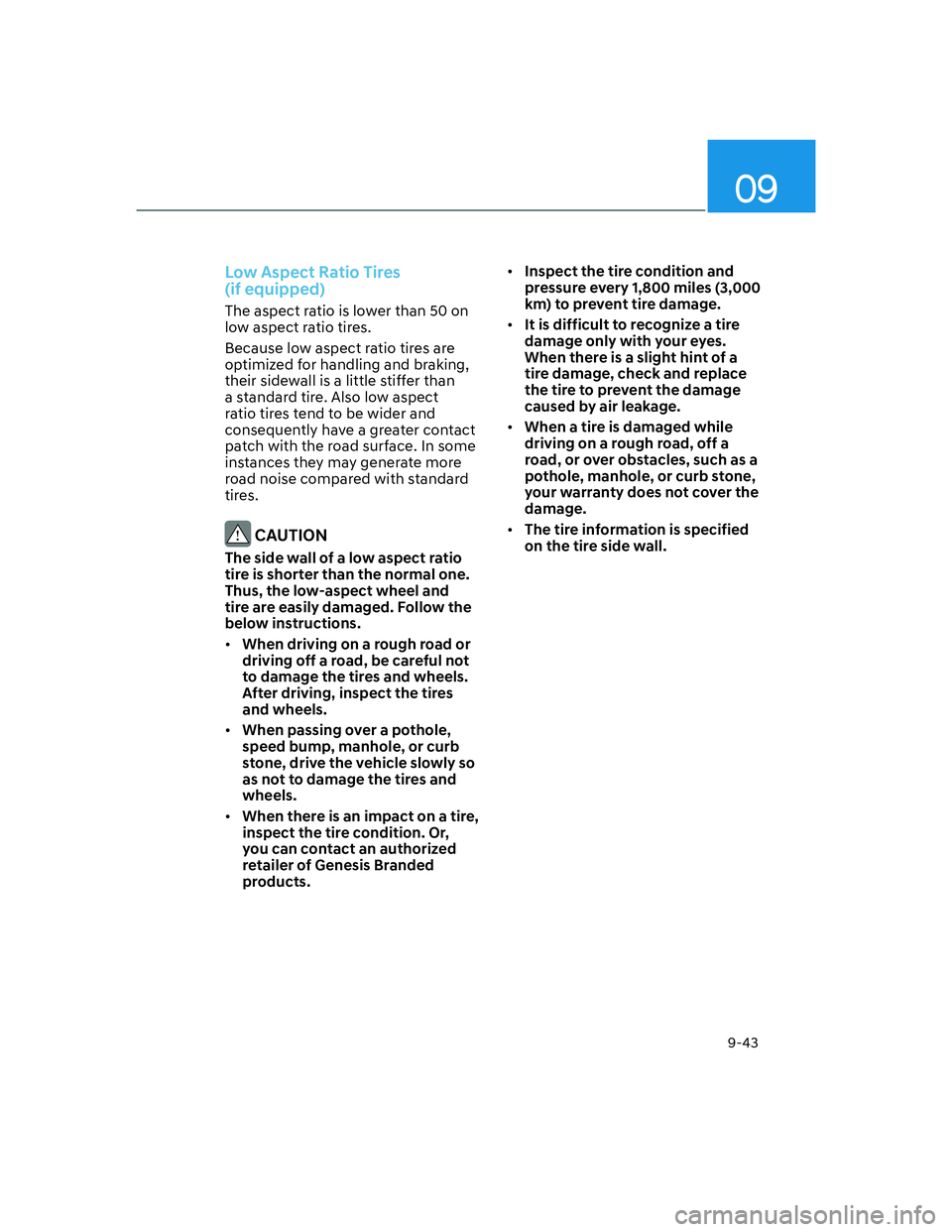
09
9-43
Low Aspect Ratio Tires
(if equipped)
The aspect ratio is lower than 50 on
low aspect ratio tires.
Because low aspect ratio tires are
optimized for handling and braking,
their sidewall is a little stiffer than
a standard tire. Also low aspect
ratio tires tend to be wider and
consequently have a greater contact
patch with the road surface. In some
instances they may generate more
road noise compared with standard
tires.
CAUTION
The side wall of a low aspect ratio
tire is shorter than the normal one.
Thus, the low-aspect wheel and
tire are easily damaged. Follow the
below instructions.
• When driving on a rough road or
driving off a road, be careful not
to damage the tires and wheels.
After driving, inspect the tires
and wheels.
• When passing over a pothole,
speed bump, manhole, or curb
stone, drive the vehicle slowly so
as not to damage the tires and
wheels.
• When there is an impact on a tire,
inspect the tire condition. Or,
you can contact an authorized
retailer of Genesis Branded
products.• Inspect the tire condition and
pressure every 1,800 miles (3,000
km) to prevent tire damage.
• It is difficult to recognize a tire
damage only with your eyes.
When there is a slight hint of a
tire damage, check and replace
the tire to prevent the damage
caused by air leakage.
• When a tire is damaged while
driving on a rough road, off a
road, or over obstacles, such as a
pothole, manhole, or curb stone,
your warranty does not cover the
damage.
• The tire information is specified
on the tire side wall.
Page 632 of 647
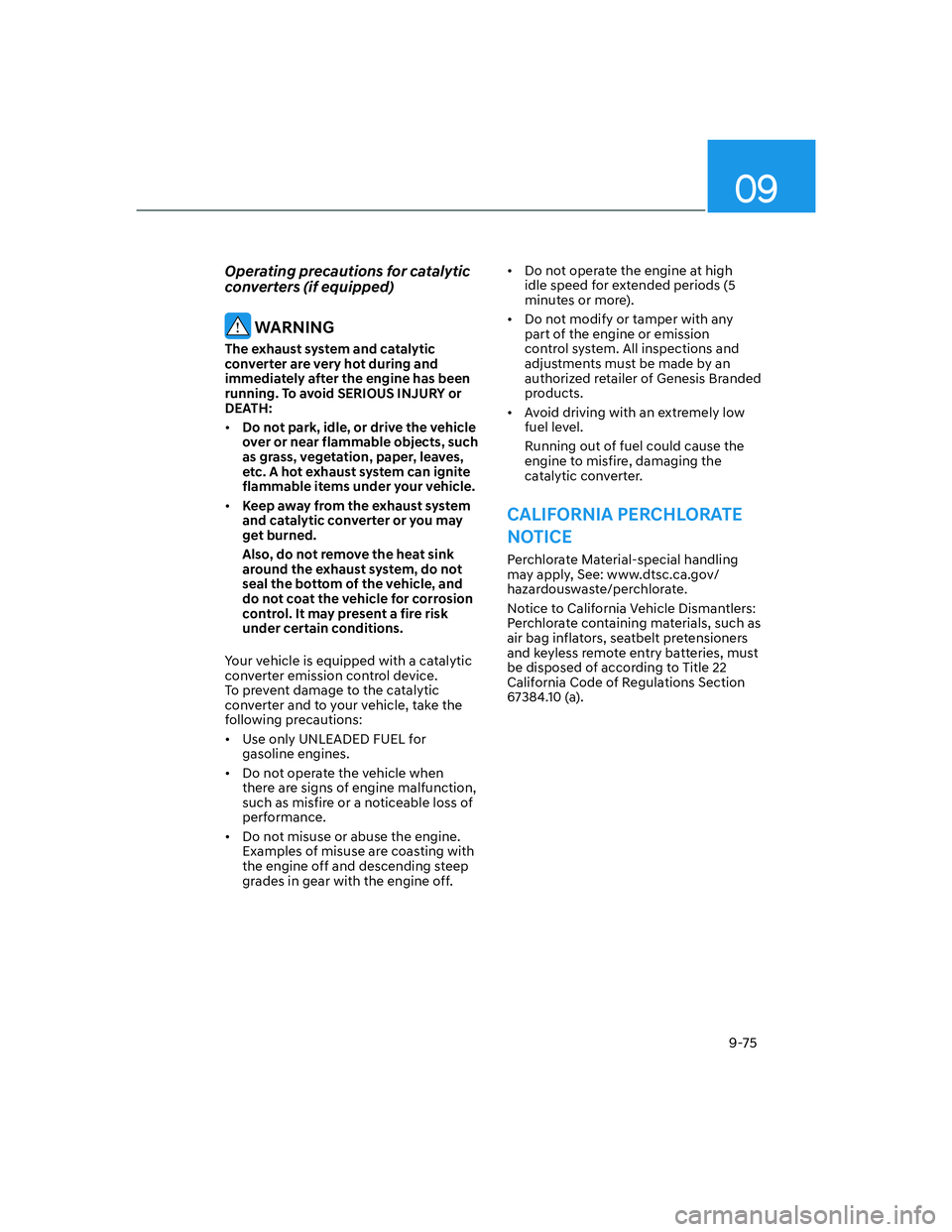
09
9-75
Operating precautions for catalytic
converters (if equipped)
WARNING
The exhaust system and catalytic
converter are very hot during and
immediately after the engine has been
running. To avoid SERIOUS INJURY or
DEATH:
• Do not park, idle, or drive the vehicle
over or near flammable objects, such
as grass, vegetation, paper, leaves,
etc. A hot exhaust system can ignite
flammable items under your vehicle.
• Keep away from the exhaust system
and catalytic converter or you may
get burned.
Also, do not remove the heat sink
around the exhaust system, do not
seal the bottom of the vehicle, and
do not coat the vehicle for corrosion
control. It may present a fire risk
under certain conditions.
Your vehicle is equipped with a catalytic
converter emission control device.
To prevent damage to the catalytic
converter and to your vehicle, take the
following precautions:
• Use only UNLEADED FUEL for
gasoline engines.
• Do not operate the vehicle when
there are signs of engine malfunction,
such as misfire or a noticeable loss of
performance.
• Do not misuse or abuse the engine.
Examples of misuse are coasting with
the engine off and descending steep
grades in gear with the engine off.• Do not operate the engine at high
idle speed for extended periods (5
minutes or more).
• Do not modify or tamper with any
part of the engine or emission
control system. All inspections and
adjustments must be made by an
authorized retailer of Genesis Branded
products.
• Avoid driving with an extremely low
fuel level.
Running out of fuel could cause the
engine to misfire, damaging the
catalytic converter.
CALIFORNIA PERCHLORATE
NOTICE
Perchlorate Material-special handling
may apply, See: www.dtsc.ca.gov/
hazardouswaste/perchlorate.
Notice to California Vehicle Dismantlers:
Perchlorate containing materials, such as
air bag inflators, seatbelt pretensioners
and keyless remote entry batteries, must
be disposed of according to Title 22
California Code of Regulations Section
67384.10 (a).
Page 634 of 647
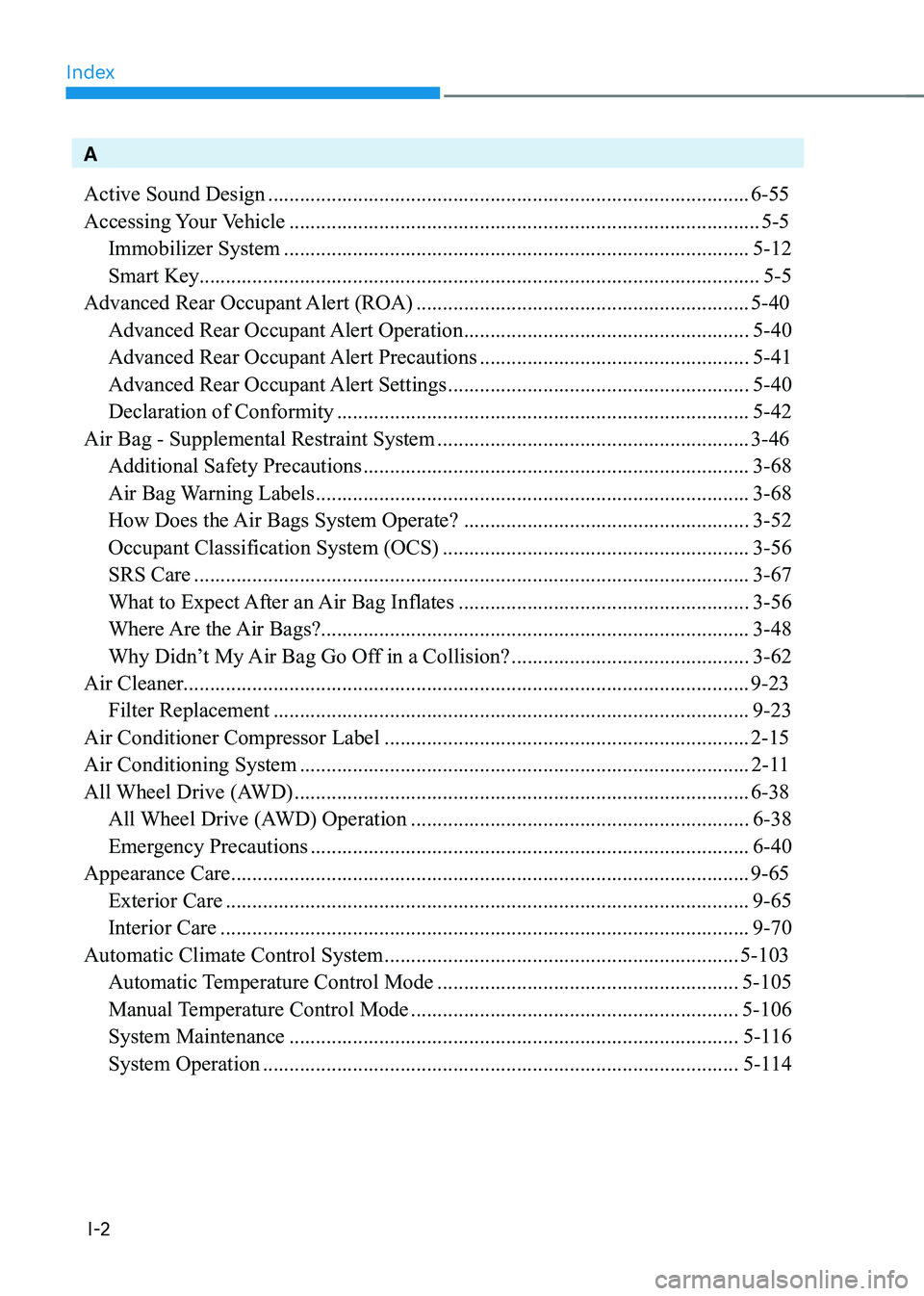
Index
I-2
A
Active Sound Design ........................................................................\
...................6-55
Accessing Your Vehicle ........................................................................\
.................5-5
Immobilizer System ........................................................................\
................5-12
Smart Key........................................................................\
..................................5-5
Advanced Rear Occupant Alert (ROA) ...............................................................5-40
Advanced Rear Occupant Alert Operation ......................................................5-40
Advanced Rear Occupant Alert Precautions ...................................................5-41
Advanced Rear Occupant Alert Settings .........................................................5-40
Declaration of Conformity ........................................................................\
......5-42
Air Bag - Supplemental Restraint System ...........................................................3-46
Additional Safety Precautions ........................................................................\
.3-68
Air Bag Warning Labels ........................................................................\
..........3-68
How Does the Air Bags System Operate? ......................................................3-52
Occupant Classification System (OCS) ..........................................................3-56
SRS Care ........................................................................\
.................................3-67
What to Expect After an Air Bag Inflates .......................................................3-56
Where Are the Air Bags?........................................................................\
.........3-48
Why Didn’t My Air Bag Go Off in a Collision? .............................................3-62
Air Cleaner........................................................................\
...................................9-23
Filter Replacement ........................................................................\
..................9-23
Air Conditioner Compressor Label .....................................................................2-15
Air Conditioning System ........................................................................\
.............2-11
All Wheel Drive (AWD) ........................................................................\
..............6-38
All Wheel Drive (AWD) Operation ................................................................6-38
Emergency Precautions ........................................................................\
...........6-40
Appearance Care ........................................................................\
..........................9-65
Exterior Care ........................................................................\
...........................9-65
Interior Care ........................................................................\
............................9-70
Automatic Climate Control System ...................................................................5-103
Automatic Temperature Control Mode .........................................................5-105
Manual Temperature Control Mode ..............................................................5-106
System Maintenance ........................................................................\
.............5-116
System Operation ........................................................................\
..................5-114
Page 636 of 647
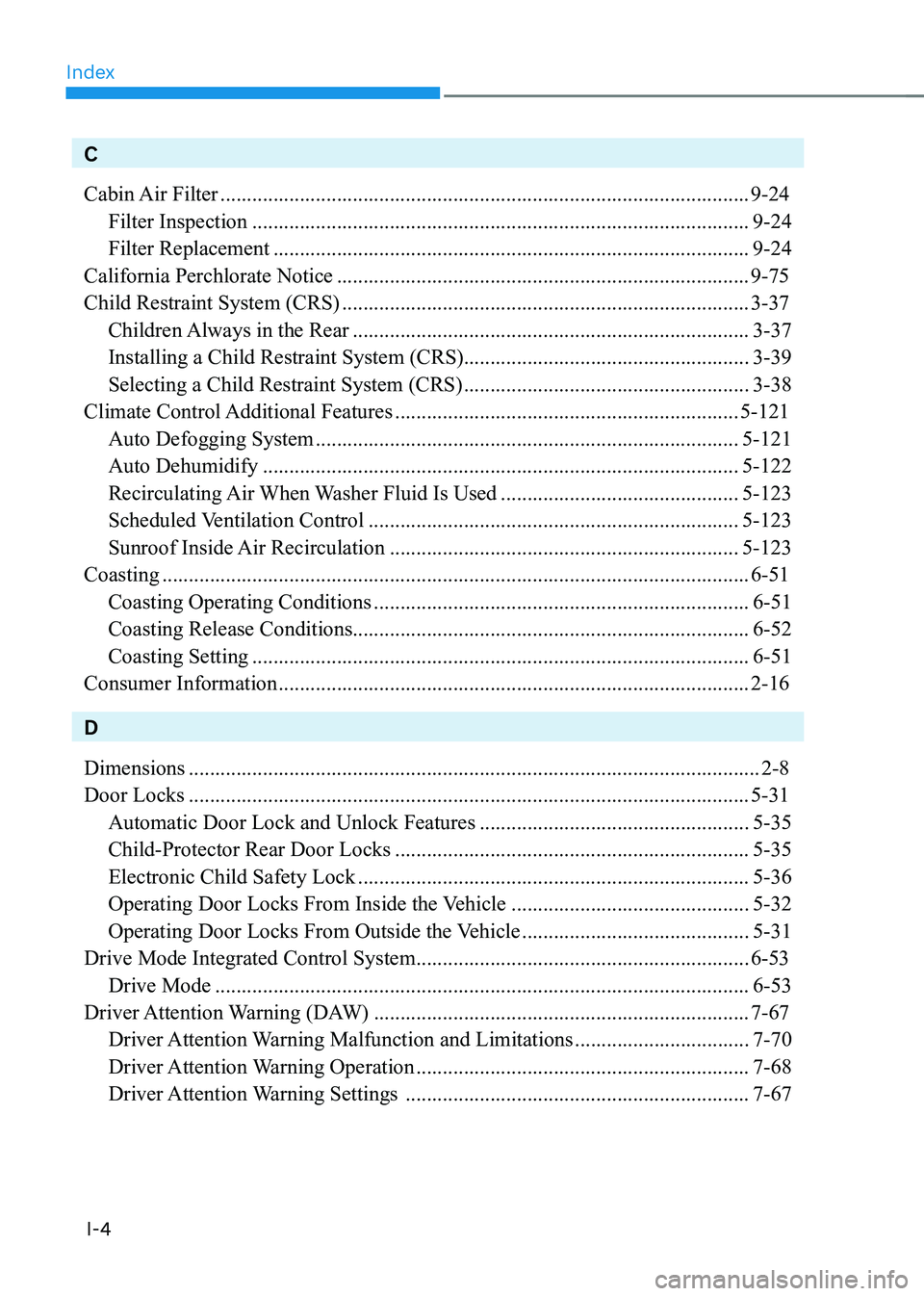
Index
I-4
C
Cabin Air Filter ........................................................................\
............................9-24
Filter Inspection ........................................................................\
......................9-24
Filter Replacement ........................................................................\
..................9-24
California Perchlorate Notice ........................................................................\
......9-75
Child Restraint System (CRS) ........................................................................\
.....3-37
Children Always in the Rear ........................................................................\
...3-37
Installing a Child Restraint System (CRS)......................................................3-39
Selecting a Child Restraint System (CRS) ......................................................3-38
Climate Control Additional Features .................................................................5-121
Auto Defogging System ........................................................................\
........5-121
Auto Dehumidify ........................................................................\
..................5-122
Recirculating Air When Washer Fluid Is Used .............................................5-123
Scheduled Ventilation Control ......................................................................5-123
Sunroof Inside Air Recirculation ..................................................................5-123
Coasting ........................................................................\
.......................................6-51
Coasting Operating Conditions .......................................................................6-51
Coasting Release Conditions........................................................................\
...6-52
Coasting Setting ........................................................................\
......................6-51
Consumer Information ........................................................................\
.................2-16
D
Dimensions ........................................................................\
....................................2-8
Door Locks ........................................................................\
..................................5-31
Automatic Door Lock and Unlock Features ...................................................5-35
Child-Protector Rear Door Locks ...................................................................5-35
Electronic Child Safety Lock ........................................................................\
..5-36
Operating Door Locks From Inside the Vehicle .............................................5-32
Operating Door Locks From Outside the Vehicle ...........................................5-31
Drive Mode Integrated Control System ...............................................................6-53
Drive Mode ........................................................................\
.............................6-53
Driver Attention Warning (DAW) .......................................................................7-67
Driver Attention Warning Malfunction and Limitations .................................7-70
Driver Attention Warning Operation ...............................................................7-68
Driver Attention Warning Settings .................................................................7-67
Page 640 of 647

Index
I-8
Important Safety Precautions ........................................................................\
.........3-2
Air Bag Hazards ........................................................................\
........................3-2
Always Wear Your Seat Belt ........................................................................\
.....3-2
Control Your Speed ........................................................................\
...................3-2
Driver Distraction........................................................................\
......................3-2
Keep Your Vehicle in Safe Condition ...............................................................3-2
Restrain All Children........................................................................\
.................3-2
In Case of an Emergency While Driving ...............................................................8-2
If the Engine Stalls at a Crossroad or Crossing.................................................8-2
If the Engine Stalls While Driving ...................................................................8-2
If You Have a Flat Tire While Driving ..............................................................8-3
Infotainment System ........................................................................\
..................5-138
Antenna ........................................................................\
.................................5-138
Bluetooth® Wireless Technology .................................................................5-140
Infotainment System ........................................................................\
.............5-139
Lexicon Premium Sound System ..................................................................5-140
Steering Wheel Remote Controls .................................................................5-138
USB Port ........................................................................\
...............................5-138
Voice Recognition ........................................................................\
.................5-139
Instrument cluster ........................................................................\
..........................4-4
Gauges and Meters ........................................................................\
....................4-5
Instrument Cluster Control ........................................................................\
........4-5
LCD Display Messages ........................................................................\
...........4-22
Transmission Shift Indicator ........................................................................\
...4-10
Warning and Indicator Lights ........................................................................\
..4-11
Instrument Panel Overview (I) ........................................................................\
......2-5
Instrument Panel Overview (II) ........................................................................\
.....2-6
Integrated Memory System........................................................................\
..........5-43
Recalling Memory Positions ........................................................................\
...5-44
Resetting the System ........................................................................\
...............5-44
Seat Easy Access ........................................................................\
.....................5-45
Storing Memory Positions........................................................................\
.......5-43
Intelligent Speed Limit Assist (ISLA) .................................................................7-62
Intelligent Speed Limit Assist Malfunction and Limitations ..........................7-65
Intelligent Speed Limit Assist Operation ........................................................7-63
Intelligent Speed Limit Assist Settings ...........................................................7-62
Page 644 of 647

Index
I-12
Reverse Parking Distance Warning (PDW) .......................................................7-141
Reverse Parking Distance Warning Malfunction and Precautions ................7-143
Reverse Parking Distance Warning Operation ..............................................7-142
Reverse Parking Distance Warning Settings .................................................7-141
S
Safe Exit Assist (SEA) ........................................................................\
.................7-52
Safe Exit Assist Malfunction and Limitations ................................................7-56
Safe Exit Assist Operation ........................................................................\
......7-54
Safe Exit Assist Settings........................................................................\
..........7-53
Safe Exit Warning (SEW) ........................................................................\
............7-46
Safe Exit Warning Malfunction and Limitations ............................................7-49
Safe Exit Warning Operation ........................................................................\
..7-48
Safe Exit Warning Settings ........................................................................\
.....7-47
Scheduled Maintenance Services ........................................................................\
..9-7
Maintenance Under Severe Usage Conditions ................................................9-11
Normal Maintenance Schedule ........................................................................\
.9-8
Seat Belts ........................................................................\
.....................................3-25
Additional Seat Belt Safety Precautions .........................................................3-34
Care of Seat Belts ........................................................................\
....................3-36
Pre-Active Seat Belt (PSB) ........................................................................\
.....3-33
Seat Belt Restraint System ........................................................................\
......3-27
Seat Belt Safety Precautions ........................................................................\
...3-25
Seat Belt Warning Light ........................................................................\
..........3-26
Seats ........................................................................\
...............................................3-3
Air Ventilation Seats ........................................................................\
...............3-23
Front Seats ........................................................................\
.................................3-7
Head Restraint ........................................................................\
.........................3-16
Rear Seats ........................................................................\
................................3-12
Safety Precautions ........................................................................\
.....................3-6
Seat Warmers ........................................................................\
...........................3-20
Smart Cruise Control (SCC) ........................................................................\
.......7-79
Smart Cruise Control Display and Control .....................................................7-85
Smart Cruise Control Malfunction and Limitations........................................7-91
Smart Cruise Control Operation......................................................................7-84
Smart Cruise Control Settings ........................................................................\
.7-80